Counterfeit drugs targeted by technology in India
- Published
WATCH: Fake drugs like these counterfeit Viagra pose a huge health risk to patients - and destroy confidence in genuine pharmaceuticals
Making pills that could save lives both in India and abroad, Indian pharmaceutical companies are growing faster than ever before.
Worth over $12bn, the industry is expected to grow more than four-fold in the coming decade.
But even as global attention is focused on the healthy growth in India, it is threatened by a serious malaise - counterfeiting. Fake drugs in the system risk not just lives of patients, but also the reputation of drug makers.
Faking it
There are varying estimates of how big the problem is. Up to 25% of the medicines consumed in poor countries could be counterfeit or substandard, according to the World Health Organisation. They define a counterfeit as "a medicine, which is deliberately and fraudulently mislabelled with respect to identity and/or source".
Counterfeit drugs are a $200bn (£128bn) industry worldwide. Producers need very little investment to set up the manufacturing process and can make huge profits.
With manufacturing costs nearly 40% cheaper than other countries, the authorities are worried India could become an easy target for counterfeiters.
This is why the government has launched a campaign against counterfeit medicines. The drug controller of India says while they have task forces that regularly raid producers, it is increasingly difficult to spot fakes.
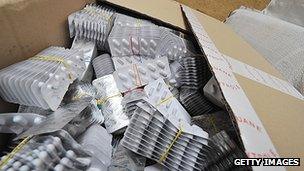
Fake drugs like these, destined for Africa, can kill
Very often consumers cannot work out if they have been treated with a counterfeit product, which may contain non-active or even toxic ingredients.
Deputy drug controller general of India, Dr D Roy, says counterfeit medicines often resemble the originals in chemical composition. But he thinks the biggest problem is the packaging.
Holding up two strips of a medicine for the common cold, he points out that its nearly impossible to find any differences in them.
"This is how consumers are deceived," he says.
"Retailers too would find it difficult to identify a fake. The packaging industry is not regulated by us. The need of the hour is to evolve a more holistic approach that ensures involvement of all stakeholders in the supply chain."
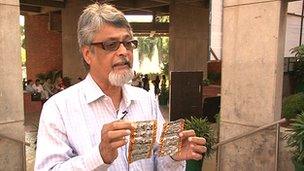
The deputy drug controller for India, Dr D Roy, shows how difficult it is to tell the fakes from the real things
Currently, when a company suspects that its drugs are being counterfeited in a particular area, they alert the local office of the drug controller to take action.
The authorities then conduct a raid and seize any fake products found.
Testing times
When a consumer suspects that a drug is counterfeit, the process to get it tested in a government laboratory is slow and expensive.
Technology is now being used to speed up the process.
A committee set up by the Indian Ministry of Health has approved a proposal to put 2D barcodes and scratch-off labels on medicines.
The label works like a telephone recharge coupon. The user scratches off the cover and texts what is underneath to a freephone number, to find out if a pill is real.
Quick response (QR) codes are also being tested. These printed squares are an advanced version of the 2D barcodes. Anyone with a camera-enabled phone and web access can scan the code and be taken instantly to the pharma company website to authenticate the drug.
Leveraging the extensive mobile usage in the country and cloud computing, the pharma industry hopes to increase their credibility. Computer companies see a huge business potential in offering technology solutions to the whole industry.
Hewlett-Packard is one of the companies offering a solution, a cloud-based platform called Global Authentication Service.
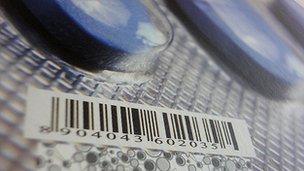
This barcode lets pharma companies track drugs through the supply chain
Pharma companies can buy two-dimensional bar codes which will be printed on the packaging material.
The companies can then use the cloud service to monitor the movement of products through their global supply chains. The system is used to trace and authenticate medicines in Nigeria and Ghana.
A Appadurai of HP India says they have used the system in Africa with non-profit social enterprise mPedigree. In India, they are in talks with pharma manufacturers like Cipla, Tablet India and the Chemical & Alkeli Merchants Association (CAMA).
Mr Appadurai says the technology would not be very expensive.
"The two dimensional barcodes would cost around one rupee each. This may mean a firm's expenditure may rise marginally. However, compared to the litigation costs some pharma companies face, this cost is nothing."
Bonding moment
In an effort measure the amount of fake drugs in the market, the pharma industry and the authorities have come together.
Measures under consideration include a certification system for pharmacists, and an open source website where consumers and companies can access data on fake drugs.
Bilcare Technologies makes anti-counterfeiting, security and brand protection technologies. These include a handheld scanner to track their security technology nonClonableIDT.
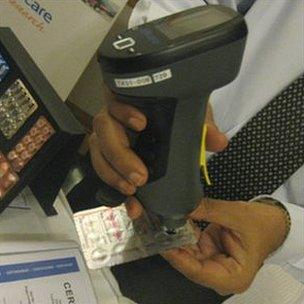
This scanner can check the authenticity of packets of pills
It's almost like a fingerprint that can be put on any product. The company claims it provides a reliable means to track and trace products across the supply chain - from manufacturer to consumer.
Another company, PharmaSecure, has come up with a technology called UIMV - unique identification mobile verification. It is a unique code for each product which can be verified by sending texts to the number given.
Manufacturers print these codes on packaging, and monitoring begins the minute the product leaves the factory. This way consignments are protected while in transit until they reach their destination.
Profits warning
Bejon Misra of the Partnership for Safe Medicines says counterfeiting eats into profits and affects the development of new formulations for medicines.
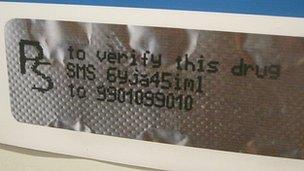
Consumers can text this number to a freephone number to find out if their medicine is real or fake
"In the perennial search for new drugs to tackle viruses and bacteria that are constantly mutating and developing resistance to current medications, the pharmaceutical industry spends billions of dollars every year towards research and development.
"If we fail to reduce the menace of spurious medicines, the cost towards health care can increase phenomenally."
Prafull D Sheth of the South East Asian Regional Pharmacy Forum says that even if a small percentage of the overall market is found to be counterfeit, it has a big impact financially.
According to the WHO the most frequently counterfeited medicines in wealthier countries are new, expensive lifestyle medicines, such as hormones, steroids and antihistamines.
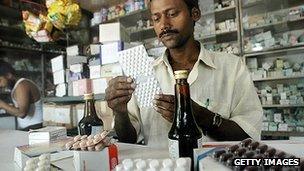
Government regulations mean drug manufacturers will have to bar code their products
While in developing countries it is those used to treat life-threatening conditions such as malaria, tuberculosis and HIV/AIDS.
The majority of fake drugs available are said to originate in India and China.
India is also one the world's fastest-growing hubs for generic drug production. A majority of the medicines available in Africa come from Indian generic drug laboratories.
Meanwhile the World Trade Organization says fake anti-malaria drugs kill 100,000 Africans a year and the black market deprives governments of 2.5-5% of revenue.
The government hopes barcoding will give credibility to the generics leaving the country. From 1 October 2011, it will be mandatory for all pharmaceutical exporters to print bar-codes on their tertiary or outer-most packaging.
The order also stipulates the compulsory implementation of a track and trace system will also include secondary-level packaging from 1 January, 2012 and primary packing from 1 July, 2012.
Paul Lalvani is dean of Empower School of Health.
He says around $5bn is invested by the big donor funds in anti-malarial and anti-retro viral drugs.
"80-90% of this comes from India. Drug makers impact the lives of over 6m people around the world who are on anti-retro viral drugs and 200m people on anti-malarials."
"So it's important for India to reassure consumers worldwide of the safety and credibility of drugs made here."
Ensuring that poor people get access to quality drugs is a top priority says the government. But counterfeiting is seriously impacting the growth the pharmaceutical sector has so far been enjoying.
Until the government is able to crack down on fake products in the marketplace, popping a pill could be life threatening.